Violet "Magic Tulip": a description of the variety and tips for care
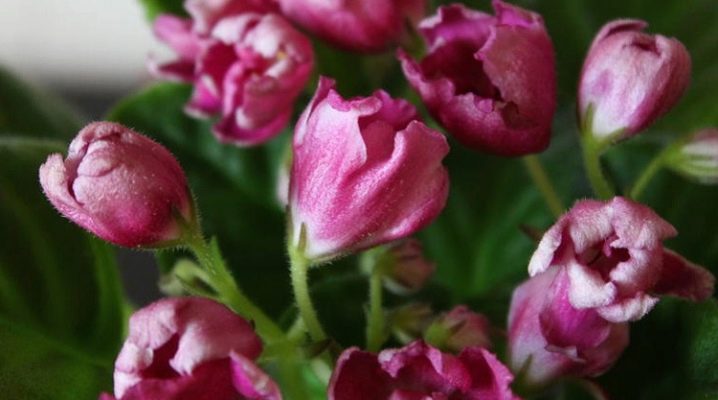
Saintpaulia "Magic Tulip" has been cultivated quite recently. Few people know, but Saintpaulias, also called uzambara violets, are not violets. However, in everyday life it is customary to call them that way, therefore this name will be found further in the text.

The name itself indicates the most prominent feature in the description of this variety. Its flowers are in the shape of a tulip, while reaching an average of 4 centimeters.... All leaves have a characteristic herbal color, oval shape. Along the periphery, the petals have a snow-white color, moving with a gradient to the middle, where there is an abundance of pink.
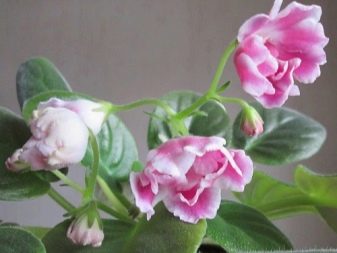
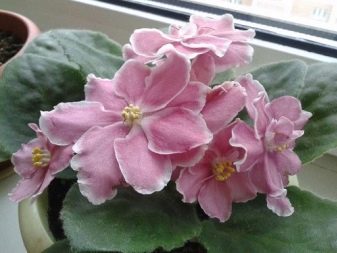
Flower features
Due to the fact that mass breeding works of more than one specialist were carried out on the flower, it has a lot of positive qualities:
- relative to other varieties, it is a large flower;
- has three dominant colors, as well as a varied color: from gradient to blotches;
- wavy, multi-coated, terry - these words can describe violet petals;
- this variety of Saintpaulias is capable of blooming for over one month;
- no developmental problems if care instructions are followed;
- direct sunlight cannot damage the petal cover.
All these features make the Magic Tulip violet more viable not only in environmental conditions, but also in the struggle for a place in the market.
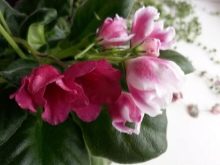
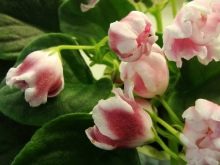
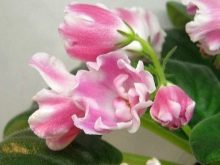
The nuances of caring for a violet
Each plant requires care and the creation of a certain atmosphere. The Magic Tulip violet is no exception.
- Light. Despite the fact that violet leaves are resistant to fading, direct sunlight negatively affects it. Violet is very light-requiring, but it is accepted, develops and blooms only in diffused light. The lack of light, as well as its abundance, is the reason for the inhibition of all production processes of the plant. The optimal time to saturate the violet with light is 12 hours.
- Warmly. A temperature of + 21 ° C is recognized as the best for growing violets. It is recommended by experts, since the constancy in the room temperature is the key to a strong plant. If you grow a violet in a room where the temperature is below normal, then the color scheme will change in the direction of increasing the size of the edges. When a violet is grown under high temperature conditions, it leaves an imprint on the subsequent offspring, the size of the fruit.
Prolonged exposure of the plant in such conditions negatively affects the growth of the violet.
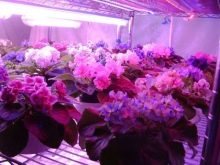
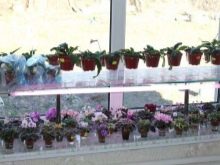
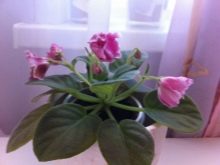
Irrigation implies several nuances that must be observed.
- No special liquid is required for watering a flower: tap water can also be used to irrigate the surface. In such cases, the procedure is carried out to remove all elements detrimental to the state of the flower. To do this, the water is settled for 48 hours, then boiled and cooled.
- So that watering gives its fruits, and does not harm the soil and plant, the water for irrigation should be at a higher temperature than the surrounding atmosphere. To determine the correctness of the selection of the water temperature, you should check the soil - it must also be warm.
- Care must be taken directly when watering. The ingress of water on the leaf and its stem can provoke rotting, therefore the following method is practiced: after watering the top layer, the container with the plant is installed in a tray with warm water.
- Rotting roots is an extremely dangerous thing. In this regard, after a quarter of an hour, the pallet with the liquid is removed.
- In case of uncertainty in the dose of water consumed by a violet, experts recommend choose the smallest volume... This is due to the fact that the violet tolerates dryness more persistently than excessive moisture.
- In addition to soil care, gardeners recommend rinse violet leaves with warm water. Twice in one season of the year is a completely workable process.
- Air humidity. Immature violets are very difficult to tolerate a dried-up climate, as well as transplanted plants. Ripe violets, accustomed to the conditions of this environment, tolerate it stably and simply. To create a more fertile soil for the plant, a greenhouse effect is created by covering the flowers with glass or polyethylene. It happens that fumes appear on the surface of the plant. This can be the result of fungal diseases, therefore, in such cases, the room is ventilated. To eliminate the cause in advance, do not go beyond the 70% air humidity mark.
- Fertile soil. In order for the plant to develop, it is necessary to provide it with a loose and rich soil. The soil can be purchased in special stores or collected in person. To create soil with your own hands, you will need: 3 parts of rotten marsh plants, 5 parts of leafy soil, 1 part of perlite and a tenth of the total mass of coal. Due to such a diverse composition, excess moisture is eliminated, the humidity of the local climate in the room is maintained.
- Capacity. The most suitable for violets are pots made of expanded clay or plastic. They guarantee the plant protection from the air and the elimination of water.
When purchasing a plastic pot, several holes must be made in it to remove water from the container.
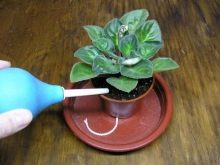
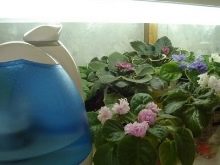
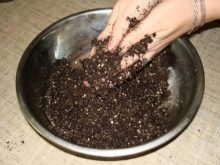
Violet diseases
The decay process is characterized by the formation of "mouse" plaque on the surface of the leaf. To eliminate this problem, the plant is carefully treated with a fungicide.
Powdery mildew is another disease. It is easy to define - the surface of the plant is covered with white droplets.
The reason for the diseases of the "Magic Tulip" violet is very simple - improper care.
Recommendations in this case are standard: following the instructions for caring for a houseplant.
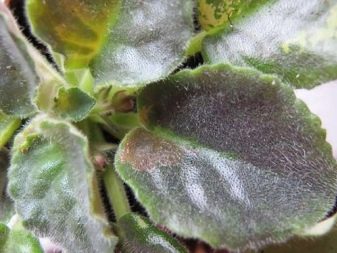
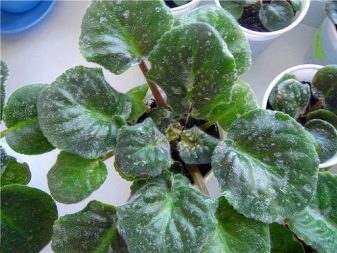
What pests are typical for violets?
To avoid getting on the plant of various types of parasites, you need to know everything about them in advance. The most common and frequent cases of infestation are the following pests.
- Mite it is impossible to determine on the surface of the plant, since it is microscopic in size. The presence of this parasite is determined by its "work": on the inside of the leaf there are characteristic spots of a chocolate shade. To combat this parasite, you will need arkacids.
- Aphid. This type of pest, like ticks, is very small in size. The most serious problem with aphids is their overly active reproduction. It is easy to avoid negative consequences if you find small insects on the buds and on the seamy side of the leaf in time. There are three types of pest control at once: mechanical assembly, removal of affected areas and localization of pests, as well as treatment of the plant with a solution of laundry soap.
- Thrips are clearly visible to the naked eye, so it will not be difficult to detect their presence in time. At the usual stage, thrips are localized on the seamy side of the leaf, but when the time for reproduction comes, they actively move around the entire plant area. Another complicating factor is that they are able to lay their offspring on the entire flower. A characteristic feature of the definition of thrips is the discoloration of certain parts of the plant. You can fight them with any of the well-known drugs of this specialization. The problem is that the adaptation of pests occurs at a high rate, so it is not easy to choose the right chemical.
- The appearance of scale insects is considered a frequent practice. Often they get to the plant through nearby "neighbors". The problem of the scale insect is its fertility: even one pest is able to fill an entire houseplant with its offspring. She, like thrips, sucks the cell juice from the violet. It can be determined by the characteristic bald spots on the green background of a healthy leaf. The delicate leaves of the violet, in the case of the scabbard, do not lend themselves to any other influence than mechanical. Pests should be removed with soapy water. But experts recommend destroying the plant, because it is a distributor of infection.
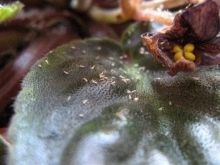
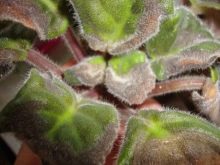
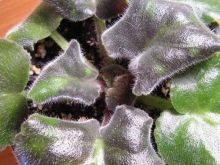
Thus, we can say that despite the innovation in relation to some points, the violet "Magic Tulip" has the main qualities: the pros and cons of a standard houseplant.
For those who like to collect and collect all kinds of colors and shapes of plants, it is an excellent specimen.
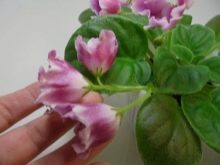
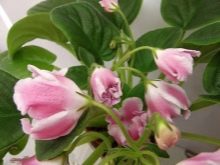

You can find out how to root a violet leaf below.































The comment was sent successfully.